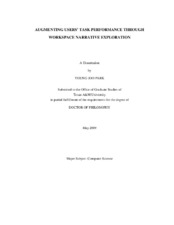| dc.contributor.advisor | Furuta, Richard K. | |
| dc.creator | Park, Young Joo | |
| dc.date.accessioned | 2010-07-15T00:12:03Z | |
| dc.date.accessioned | 2010-07-23T21:43:36Z | |
| dc.date.available | 2010-07-15T00:12:03Z | |
| dc.date.available | 2010-07-23T21:43:36Z | |
| dc.date.created | 2009-05 | |
| dc.date.issued | 2010-07-14 | |
| dc.date.submitted | May 2009 | |
| dc.identifier.uri | https://hdl.handle.net/1969.1/ETD-TAMU-2009-05-457 | |
| dc.description.abstract | In a fast-paced office setting, information workers inevitably experience expected and unexpected interruptions daily. As the volume and the diversity of information and application types grow, the impact of frequent interruptions on their task performance gets more severe. To manage the negative effects of interruptions on work performance, workers often engage in task management activities to ensure they are better prepared to resume suspended task less stressfully. However, managing tasks causes additional cognitive burden and a time cost to users who already are experiencing the tight attention and time economies.
This dissertation presents an approach to augmenting users' task performance by allowing them to manage and retrieve desired work contexts with ease. The Context Browser, the implementation of the proposed approach, is designed to help the users to explore narratives of their workspace manner and restore their previous work contexts. The goals of implementing the Context Browser are to 1) unload the users? burden of taking care of their task-related or task status information promptly and thus help them focus solely on executing a given task, 2) allow them to browse their previous workspace intuitively, and 3) enhance continuity of their tasks by supporting them to retrieve desired work context more quickly and easily. In order to validate the proposed approach, a user study comparing task performances of the group with the Context Browser to the one without the Context Browser was conducted. The study produced both quantitative and qualitative results. The study confirmed that with the Context Browser subjects expressed better quantitative numbers than the ones without. Subjects using the Context Browser were able to restore and retrieve their desired work setting and task-related information more quickly and correctly. Qualitative results showed that the subjects using the Context Browser found that various contextual cues and the interfaces responsible for providing the cues offered effective artifacts to help them recover both cognitive and work contexts, while the other subjects experienced a difficult time in restoring the desired contexts that were necessary to perform their assigned tasks. In addition, we re-invited 6 subjects from the group without the Context Browser 6 weeks after the study. We asked them to perform the same tasks as the ones they did 6 weeks before with the Context Browser. It showed that with the Context Browser they outperformed their previous performance even after a lengthy period. | en |
| dc.format.mimetype | application/pdf | |
| dc.language.iso | eng | |
| dc.subject | Workspace, interruption, task, narrative, context browser, discontinuity | en |
| dc.title | Augmenting users' task performance through workspace narrative exploration | en |
| dc.type | Book | en |
| dc.type | Thesis | en |
| thesis.degree.department | Computer Science | en |
| thesis.degree.discipline | Computer Science | en |
| thesis.degree.grantor | Texas A&M University | en |
| thesis.degree.name | Doctor of Philosophy | en |
| thesis.degree.level | Doctoral | en |
| dc.contributor.committeeMember | Shipman, III, Frank M. | |
| dc.contributor.committeeMember | Leggett, John J. | |
| dc.contributor.committeeMember | Smith, Steven M. | |
| dc.type.genre | Electronic Dissertation | en |
| dc.type.material | text | en |


